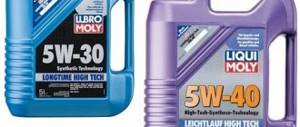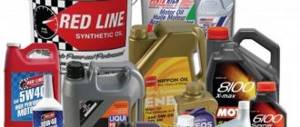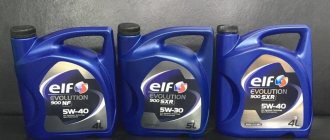Types of oils
First, let's determine what types of oils can be found on sale.
All automobile oils can be divided into two large categories - motor and transmission.
Transmission fluids are divided into fluids for manual transmissions (MT) and automatic transmissions (AT).
Based on the origin of the base components, motor and transmission oils can be mineral, synthetic or semi-synthetic.
Pouring transmission oil into the engine
It is worth saying that currently all types of gearbox oils are high-quality synthetics. Lubricants may be intended for automatic/manual transmissions.
Medium-viscosity products are usually poured into mechanical boxes. They cannot be used in automatic transmissions.
What happens if you accidentally pour transmission oil into the engine?
Nothing good. If you have added “transmission” to the power unit, be prepared for the following:
- in high-temperature conditions, the “transmission” will burn out. Oil channels, pipes, and oil filters will become clogged. Precipitation may occur;
- If you pour transmission oil into the engine, it will not lubricate the cylinder block, shafts, and so on. Bullies will begin;
- The “transmission” is very dense. The seals will begin to squeeze out and they will begin to leak;
- Through scuffs in the cylinder walls, the oil will enter the combustion chamber, exhaust manifold, and catalyst, which will undergo melting. We'll have to replace it;
- The “transmission” will most likely end up in the intake manifold. This will cause the throttle valve to become dirty. You will have to clean it up (unless, of course, the machine breaks down first);
- The spark plugs will become dirty, causing the engine to run unevenly.
Differences between transmission and engine oils
What is the difference between motor and transmission oils?
Materials of each of the two types are developed taking into account the conditions in which they will be used.
Engine oils and transmission oils (motor oil and fluid for manual transmissions or automatic transmissions) operate under completely different conditions.
Motor lubricants are exposed to very high temperatures, experience both normal and extreme loads, and interact with fuel combustion products and gases.
Transmission lubricants do not experience such severe temperature changes and do not interact with aggressive environments. However, they have to take on much heavier loads. Taking into account the specifics of the tasks being solved, motor and transmission fluids contain completely different additive packages.
Transmission fluids have a viscosity higher than motor oils. Increased viscosity allows the lubricating film formed by oil on rubbing surfaces to withstand higher loads and provide parts with reliable protection.
What is the difference between lubricants for internal combustion engines and gearboxes?
These 2 petroleum products are used under completely different conditions. There is also a difference between them in the constituent elements and technical indicators. Lubricants are divided into mineral water, semi-synthetic and synthetic.
They also differ in the content and type of additives that are added to the petroleum product to improve performance. The choice of additives depends on operating conditions.
The engine process is tougher than the transmission
The conditions under which engine oils are used are much harsher than those of transmission consumables. Temperature jumps and compression changes constantly occur in the engine.
Lubricants are affected by various gases, fuel and its residues. This doesn't reflect well on them. The use of lubricating fluids is due to the fact that they:
- are a sealing element between the cylinder block, piston system and rings;
- protect spare parts from corrosive effects to the maximum;
- remove heat from contacting parts.
How to distinguish transmission lubricant from motor lubricant?
The most important features that allow you to visually distinguish these two types of oils are the markings on the label and their organoleptic characteristics.
- Having a container with a label, it is not difficult to distinguish one product from another. Labels on the packaging clearly identify the contents and indicate the type and viscosity of the oil
- You can also determine the type of oil in the following way: squeeze your index finger and thumb and dip their tips into the identified composition. After removing it from the liquid, we slowly unclench our fingers and observe the behavior of the liquid. Motor oils are more viscous, so the rupture of a drop of liquid between the fingers does not occur immediately, but when the distance between the fingers reaches several millimeters
- These lubricants also differ in smell. If they were in a tightly closed sealed package, then, according to auto repairmen, the aroma of the gear oil will differ in the presence of garlic or sulfur undertones
- However, the most reliable and easiest way to distinguish gear oil from motor oil is to simply drop the liquid into water. If it instantly spreads over the surface and creates a film with a rainbow color on the surface of the water, this is a transmission. If the drop does not dissolve and has acquired a spherical or lens-shaped shape, then you have motor oil in your hands
Why do you need gear oil?
Like motor lubricants, transmission lubricants perform a number of functions. Among them:
- lubrication and prevention of wear of rubbing surfaces;
- reduction of shock loads;
- reduction of power losses associated with overcoming friction;
- anti-corrosion protection of units;
- removal of heat and wear products.
Additionally, gear oil for manual transmissions can reduce the noise level from meshing gear pairs. In addition to the gearbox, transmission fluid is poured into other units: transfer cases, axles, differentials.
Is it possible to pour motor oil into the gearbox?
We previously discussed that transmission and engine oils operate under very different conditions. Accordingly, the properties of liquids of these two groups are very different. Motor oil, although it performs in harsher conditions, is not designed to withstand the loads and temperatures that transmission fluids must endure.
Differences in the chemical composition and additive packages do not allow us to predict how engine oil will behave when added to the gearbox or how the additive package will work in conditions for which it is not designed.
For cars with classic layouts, for example, even if a different type of transmission oil is poured instead of the recommended one, the unit may need to be repaired after just a few thousand kilometers.
Thus, we answer the question - is it possible to pour engine oil into the box? In general, this should absolutely not be done!
However, there are some exceptions to this rule.
- For some models of front-wheel drive vehicles, manufacturers allow the possibility of short-term use of motor oils in gearboxes, warning that the service life in this case is reduced by up to 30%.
- There is a group of universal products that are used as motor, transmission, and hydraulic fluids. However, these materials are used only in special equipment and are not applicable for ordinary vehicles.
- Some automakers, including Honda, Peugeot and Chrysler, allow motor oils to be poured into the box for some of their models.
- A historically well-known example is that in the USSR, in the first Zhiguli models, engine oil was poured into the gearbox at the factory. The design features of cars of those times made it possible to do this without much damage to the car. However, this decision was most likely caused by a lack of special transmission fluids.
Engine oil in automatic transmission
It is difficult to even imagine why a car owner in his right mind would fill an expensive automatic transmission with a fundamentally unsuitable transmission oil, not to mention motor oil. Let's discuss in theory what the consequences of using motor lubricants in automatic transmissions are.
Lubricants for automatic transmissions (so-called ATF fluids) are actually closer in their properties to hydraulic oils than to motor oils. Therefore, if there was a question about using a “spindle” or other hydraulic oil in a machine, one could think about some kind of interchangeability.
Motor oil is quite different from ATF fluids.
- Inappropriate temperature conditions. Automatic transmission fluids, even in severe frosts, maintain acceptable fluidity relative to motor oils. Relatively speaking, if the oil thickens to the consistency of, for example, honey, then the hydraulics (starting from the torque converter, pumping through the hydraulic plate) will be partially or completely paralyzed. Although there are winter oils that remain quite liquid even at very low temperatures (0W standard). So this point is very conditional.
- Unpredictable operation under high pressures. One of the prerequisites for normal operation of an automatic transmission is the predictability of oil behavior under pressure. An automatic transmission is a complex mechanism consisting of an extensive system of hydraulic channels. Each channel has its own strictly standardized values of pressure and flow rate. The liquid must not only be incompressible and transmit force well, but also in no case form air pockets.
- An unsuitable additive package that will damage the box. The only question is how long it will take for the consequences to appear. The mechanical part in an automatic transmission operates with high contact loads, which engine oil cannot cope with at its peak. Scouring and chipping of teeth is a matter of time. And rich engine oil additives, which are designed for 10-15 thousand kilometers in the engine (and in completely different conditions than in automatic transmissions), can precipitate. Deposits in the valve body will certainly cause problems.
In general, pouring engine oil into an automatic transmission can only be done as a sophisticated and expensive experiment: how long will an automatic transmission last on engine oil. Even the most expensive and technologically advanced motor oil is not suitable for normal operation in an automatic transmission.
What happens if you fill in engine oil instead of transmission oil?
If you pour engine oil into the gearbox, then at first nothing terrible will most likely happen. However, due to the fact that its characteristics differ significantly from those required by the operating conditions of the mechanism, in most cases increased wear of its parts will occur.
Thus, if you fill a manual transmission or automatic transmission with engine oil, there is a high risk of the box failing after just a short time.
If the car manufacturer directly indicates that engine oil can be poured into the gearbox, then you can follow its recommendations.
Transmission oils
Drivers do not need to buy such petroleum products as often as motor oils. If you have filled the gearbox with lubricant, you will have to change it only after a few years.
Oil fluid has found its application not only in automatic/manual transmissions. It is poured into axles, gearboxes, steering columns, and other units that have toothed gears.
The transmission consumable is distinguished by what it provides:
- Minimum wear of contacting parts due to the forming lubricant film.
- Reduced losses when gears contact.
- Heat removal from working spare parts.
- Removal of formed wear products.
- Preventing corrosive effects on the unit.
- Reducing noise from operating components.
Transmission oil is inexpensive and does not require frequent replacement. It ensures the safety and longevity of the vehicle. In order to increase the quality of such lubricants, various additives are added to them.
Experts advise adhering to the rules specified in the operating manual.
In certain front-wheel drive cars, you can pour motor oil into the gearbox for a short period of time, but it should be remembered that the service life of the transmission is reduced by approximately thirty percent.











